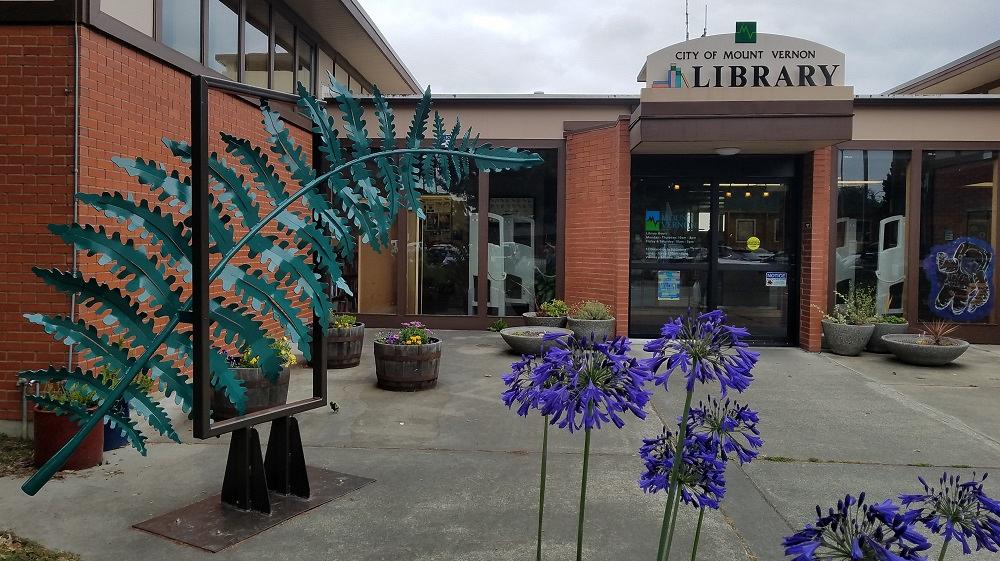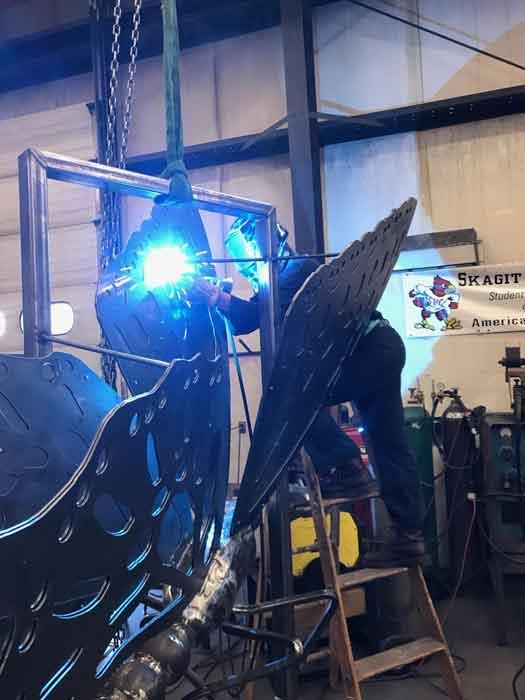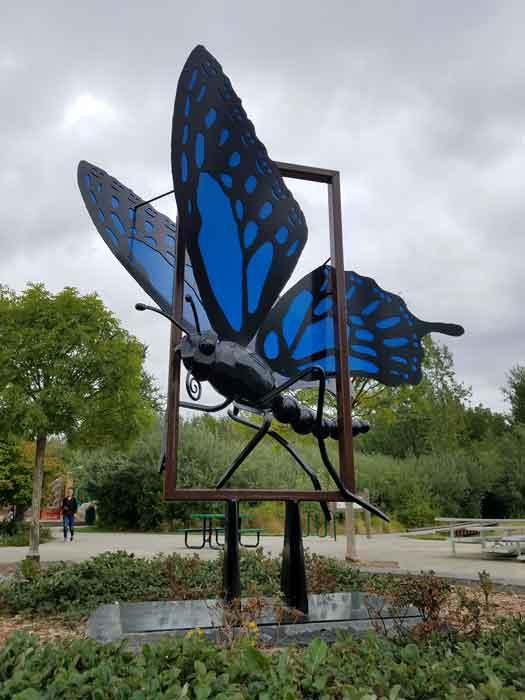- FMA
- The Fabricator
- FABTECH
- Canadian Metalworking
Categories
- Additive Manufacturing
- Aluminum Welding
- Arc Welding
- Assembly and Joining
- Automation and Robotics
- Bending and Forming
- Consumables
- Cutting and Weld Prep
- Electric Vehicles
- En Español
- Finishing
- Hydroforming
- Laser Cutting
- Laser Welding
- Machining
- Manufacturing Software
- Materials Handling
- Metals/Materials
- Oxyfuel Cutting
- Plasma Cutting
- Power Tools
- Punching and Other Holemaking
- Roll Forming
- Safety
- Sawing
- Shearing
- Shop Management
- Testing and Measuring
- Tube and Pipe Fabrication
- Tube and Pipe Production
- Waterjet Cutting
Industry Directory
Webcasts
Podcasts
FAB 40
Advertise
Subscribe
Account Login
Search
College welding club in Washington fabricates artwork for community
Skagit Valley College Welding Club sculptures decorate public spaces in Mount Vernon
- By Sue Roberts
- October 13, 2019
- Article
- Arc Welding

Sakgit Valley College Weld Club designed and constructed a large metal art piece depicting a fern through a frame for the Mount Vernon City Library in Mount Vernon, Wash.
One new sculpture a year. That’s the agreement between Washington’s city of Mount Vernon and the Weld Club of Skagit Valley College (SVC). When completed in 2020, club members will have envisioned, designed, and built 10 sculptures.
Collaboration between the city and college started when Mary Kuebelbeck, welding instructor and Weld Club adviser, accepted the position at SVC. A flock of snow geese soaring around the city’s welcome sign was the club’s first contribution to public art. It encouraged community interaction and paved the way for the multi-sculpture project.
“Mayor Jill Boudreau asked if we could help with the snow geese project,” Kuebelbeck said. “Along with welding, the wings involved metal forming. Since we didn’t have the forming equipment on campus, we turned to a local fabricating shop. They taught us how to run the slip roller. The flock turned out well.
“From there she asked us to participate in the sculpture project. We teamed with Skagit Regional Hospital for the first four steel sculptures. They are displayed along the city trail system to add interest and encourage good health by walking. For the remaining six, we are working through the Arts Council. The concept for all the sculptures is nature—getting out and enjoying it.”
The project offers good, hands-on welding experience for the students; creates public art that fits within the city budget; and generates a strong community connection with the art itself.
“When we install a sculpture, we have a dedication ceremony that includes a presentation by the mayor. Parents and community residents attend. There is a great sense of accomplishment and belonging,” Kuebelbeck said.
Building in Unique Features
Common design elements for the sculptures make them a bit unusual. All share the same rectangular shape, approximate size, and mounting system so they are interchangeable. The butterfly that has landed in Kiwanis Park may eventually spend time at any of the other nine locations.
“Concepts are born via students,” Kuebelbeck said. “Weld Club gets together and brainstorms. Students yell out ideas, we narrow it down, decide what our skills will allow, and zoom in.” Some students have dedicated as many as 40 hours to producing a sculpture.
Building each sculpture is definitely a learning process. At times a design may need to be reworked to accommodate skill levels. It’s not unusual to have club members perform a complicated procedure two or three times before they are satisfied with the outcome. Also, they learn about budgeting and have found it necessary to redesign to reduce costs. Club members contract to complete other projects to raise funds that help pay for materials and processes that are not available in-house.
“The need to redesign happened with the butterfly. We had this romantic notion that it would easily come together. That didn’t happen. We had to rework how to build the wings and get down to some different strategies,” Kuebelbeck said.

Mary Kuebelbeck, a welding instructor and SVC Weld Club adviser, assists with a difficult weld on the butterfly wing.
The major problem was economically adding color. Powder-coating multiple colors to the 1,600-pound butterfly’s 10-foot wing span was too pricey. An innovative workaround redesigned the wings to be built with three layers. A center layer of blue powder-coated steel slides between black exterior layers to show through the cut-out motif.
Growing Club Membership
Excitement triggered by the project is reflected in club membership. There were three members when Kuebelbeck became adviser in 2013. Now there are 35. Although most members come from the welding classes, all students are welcome.
“While working on the butterfly we had students from welding, two from manufacturing, one from environmental conservation, and one from the nursing program. We brainstorm and problem-solve as a group. Students from other academic areas can contribute ideas that start with experiences we might not have had,” Kuebelbeck said.
Although their primary focus is on the Mount Vernon sculptures, club members continue to accept other projects. They have worked from prints to build signs for other cities and designed and built an 18-ft.-long aluminum pontoon boat. They will be producing a smaller version of the butterfly for placement on campus. Money earned will buy some materials and help send students to FABTECH®.
Sharing Enthusiasm and Knowledge
A metal sculpture in a park triggered Kuebelbeck’s interest in welding.
“I wanted to figure out what it was all about, so I took a welding course. I was the only woman in the class, but my instructor welcomed me, asked what I wanted to do, and taught me.
“A lot of times one person or one experience can change our lives. For me, that one instructor made the difference. I hope I can be that one instructor too.”
About the Author

subscribe now

The Fabricator is North America's leading magazine for the metal forming and fabricating industry. The magazine delivers the news, technical articles, and case histories that enable fabricators to do their jobs more efficiently. The Fabricator has served the industry since 1970.
start your free subscription- Stay connected from anywhere

Easily access valuable industry resources now with full access to the digital edition of The Fabricator.

Easily access valuable industry resources now with full access to the digital edition of The Welder.

Easily access valuable industry resources now with full access to the digital edition of The Tube and Pipe Journal.
- Podcasting
- Podcast:
- The Fabricator Podcast
- Published:
- 04/16/2024
- Running Time:
- 63:29
In this episode of The Fabricator Podcast, Caleb Chamberlain, co-founder and CEO of OSH Cut, discusses his company’s...
- Trending Articles
How to set a press brake backgauge manually

Capturing, recording equipment inspection data for FMEA

Tips for creating sheet metal tubes with perforations

Are two heads better than one in fiber laser cutting?

Hypertherm Associates implements Rapyuta Robotics AMRs in warehouse

- Industry Events
16th Annual Safety Conference
- April 30 - May 1, 2024
- Elgin,
Pipe and Tube Conference
- May 21 - 22, 2024
- Omaha, NE
World-Class Roll Forming Workshop
- June 5 - 6, 2024
- Louisville, KY
Advanced Laser Application Workshop
- June 25 - 27, 2024
- Novi, MI



























